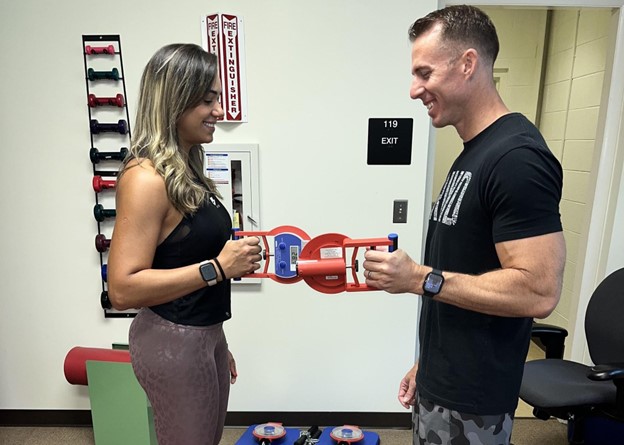Many people who take up fitness have a common objective: to build muscle and, more specifically, lean muscle. They want to boost their metabolism and alleviate concerns about their overall health—both in terms of weight and appearance. Whether their motivations are based on ensuring they look good in the clothes that seem impossible to zip past a certain time of year or that they can perform with the authority expected of someone half their age, these individuals genuinely like the idea of being healthy—and they’re willing to put in the work that necessitates otherwise elusive results.
Why is it crucial for bodybuilders to build lean muscle?
It’s not just about how muscular one appears; it’s about being powerful. Power is what every bodybuilder wants, except probably when they’re on the scale. Generally speaking, periosteal fibres (those that run along bones) make up a significant portion of what we call ‘muscle mass.’ With a base of lean muscle, you’ll be able to perform lifts at or near your heaviest and explosively enough to light up the pedometers (metabolic testing devices) in any half-reasonable range without totally blowing out your ankles, knees, or hips. Assistant
Bodybuilding is not the only beneficiary of lean muscle mass; overall fitness, endurance, power output, and athletic performance are enhanced by it. As a bodybuilder, you’ll achieve a more defined and toned appearance. However, the path to achieving this look isn’t easy—only hard gained.
When I was just starting out, my old coach would often say that if someone wanted to look good naked or semi-covered (in survey-level undies), they had better be prepared either to spend a lot of money on gym memberships or personal training or else put in some serious time at home with weights that seemed heavy as leaden hammers when I swung them. Ultimately, though—and here’s the key—to looking like a well-built young person who hasn’t taken too much for granted at an early age one needs incontestable strategies and techniques for doing so. And these are what follow next– the strategies.
- Unlocking New Career Paths with Online Courses
- FAAN set up task force to end touting, extortion at airports
Strategies for Building Lean Muscle
1. Embrace Compound Exercises
Squats, deadlifts, bench presses, and rows are what we call compound exercises. They simultaneously engage multiple joints and muscle groups—our bodies’ most potent sources of power and strength.
These exercises tap into our deep pools of twitch fibres (fast-twitch muscle fibres), which propel us forward when we do these massive movements underweight; they also get our slower, longer-duration muscles on board as well—our endurance engines—it helps to sustain the movements over time and with heavy weight.
2. Progressive Overload For Growth
Progressive overload is a fundamental part of bodybuilding and is crucial for gains in mass. Just what is progressive overload, though? Simply put, it means twisting or turning the screw of tension on your muscles while you’re working out—without adding too much weight (you can do that by increasing the number of reps or sets)—to keep your body adapting to the workout. Your body will adapt to any demand you make of it.
You will need to incorporate progressive overload If you want your body to get stronger, make it handle more stress during a workout than it did previously; if you want muscle growth, you will need to challenge those stubborn fibres.
The amount of time spent doing resistance training affects adaptation and can influence which fibres are targeted for growth—that’s important because some science suggests that different types of muscle fibres have different roles in our bodies. In ‘The Journal of Strength and Conditioning Research,’ Basil Fể et al published a meta-analysis finding that using proper form Progressive Overload with dumbbells means using at least one additional rep (but no more than three) over what was done in previous workouts–building up gradually.
3. Use The Power of Low Reps, High Weight
Optimal muscle growth comes from using a weight that challenges you in the latter part of your repetition. This is not some kind of top-secret knowledge passed down from generations of bodybuilders but rather a basic understanding ingrained into almost any conversation about how to build massive amounts of muscle, specifically with lean mass. That’s because those kinds of gains tend to come best from working with weights that force you into a high level of tension and into doing too few reps for most average lifters.
4. Rest For Quick Recovery
Don’t discount rest and recovery as important for intense muscle growth. Yes, we’ve reached a point where we know that intense training is necessary (and sufficient) for muscle hypertrophy, but can too much intensity be a bad thing? Can rest and recovery almost become the ‘flip side’ to our demanding training stances? During your workouts, do you ‘chill’ in between sets — I mean, what else can you do when you’re waiting for blood circulation and oxygen delivery to return to your worked-on muscles?
At the gym, you can take advantage of relax and recovery sessions with HydroMassage Beds and Lounges, which help you relax and rejuvenate between or after workouts.”
It should be “I mean, what else can you do when you’re waiting for blood circulation and oxygen delivery to return to your worked-on muscles? At the gym, you can take advantage of relax and recovery sessions with HydroMassage beds and Lounges, which help you rest and rejuvenate between or after workouts.”
Outside of these moments in the gym (or anywhere really), what are the chances that incorporating rest days into one’s nearly week-long training schedule could prevent overreaching or even overtraining?
5. “Build” Your Body for Bodybuilding
To support your muscle-building training, make sure to consume a balanced diet with enough nutrients. Although carbohydrates and healthy fats are crucial for energy production and adequate nutrient absorption, sufficient protein in your diet is essential for not only maintaining but also growing muscle.
A lesser-known fact is that the body’s inability to synthesize certain amino acids (the building blocks of proteins) means that you must take them in from food sources or supplements for the ongoing construction of muscular fibres. Consuming too little protein impairs this process and can even cause muscles to atrophy or shrink—it happens sometimes when people are placed in safe haven dietary restrictions during times of hardship because they have no access to functional amounts of animal-derived proteins like beef, chicken, fish, or eggs; these are high-quality protein sources.
A weak correlation between body weight and the amount of protein needed exists: generally speaking, Federal Dietary Guidelines recommend 0.8 grams of protein per kilogram (2.2 pounds) daily—the more you weigh, the more protein you should consume daily relative to your body weight. For instance, if we take a person who weighs 90 kg (198 lbs), they would need roughly 66g of protein daily for maintenance and 45 kg of lean muscle growth (e.g., say from doing calf raises while standing on one leg).
6. Prioritize Sleep for Recovery
Optimal recovery ensuing from a workout is made possible by the body’s hormone production. Growth and repair occur as these vessels empty into the circulatory system during rest, not while we’re supposedly “building” muscle with our weights.
7. Consistency is the Ultimate strategy
The process of building lean muscle takes time and is mainly about consistency. Bodybuilding, for the most part, is not an up-and-down practice but rather a consistent one that requires sticking to a plan, especially when it comes to motivation.
A routine needs to be followed with precision in order to allow one’s body ample time for adaptation. Conversations with experienced bodybuilders often reveal that they’ve achieved prestigious results mostly because they’ve put in more consistent effort over a longer period of time than average folks like you and me.
Bonus Tip: Track Your Progress
One strategy to help you stay fired up about your muscle-building goals is to monitor your progress. I think this is particularly powerful because it takes the wondering and speculating out of the equation for you. When you know how close you are to achieving a new personal best, where you need to push yourself back into the comfort zone that leads to growth, or what changes are happening vis-à-vis your body (as seen in photos) and performance, you’re more likely to feel pumped and ready to keep going after a workout even when your muscles ache as hell.
Key Takeaway
Proper form is vital. Even if it feels awkward at first, correct form will eventually become second nature—partly because you understand the movements more intimately and partly because the body adjusts to the new ways of moving that are prescribed by various exercises for maintaining fitness. Again: if ever in doubt, seek guidance from someone who knows what they’re doing!
Pay attention to your body’s signals. If you feel persistently fatigued, sore, or if there is a clear drop-off in your level of performance, it may very well be a sign that you need more time for recovery. And I’m not just talking about the kind of rest that says, “I’ll push through and then take an eight-hour night,” but active recovery with the aid of recovery supplements that keep your body moving while it renews itself at the same time.
If you’re just beginning an exercise routine or have health concerns, it’s almost always necessary to seek the guidance of a healthcare professional or personal trainer. They can give you extremely valuable and individualized advice, helping you avoid potential pitfalls in your fire-hooped path toward wellness.
Conclusion
Achieving a balanced body composition with lean muscle mass and adequate body fat percentage is a laudable aim. For many, the journey toward such an end goal starts with proper planning—both periodized and individualized—and a good understanding of the various components involved in building (or maintaining) one’s muscles.
From ANOVA charts to Excel spreadsheets, there are plenty of methods for tracking not only your progress but also the myriad numbers associated with your wellness endeavours. Still, what do all these facts and figures have to do with visualizing one’s muscular physiology? In principle, seeing how you look while on your way to achieving your fitness goal can help motivate you to push through days when working out feels like something to get through
Seeing how you look while reaching for an ambitious fitness goal can also help give some sense of just how close or far off that seemingly in-reach milestone really is.

 Join Daily Trust WhatsApp Community For Quick Access To News and Happenings Around You.
Join Daily Trust WhatsApp Community For Quick Access To News and Happenings Around You.


